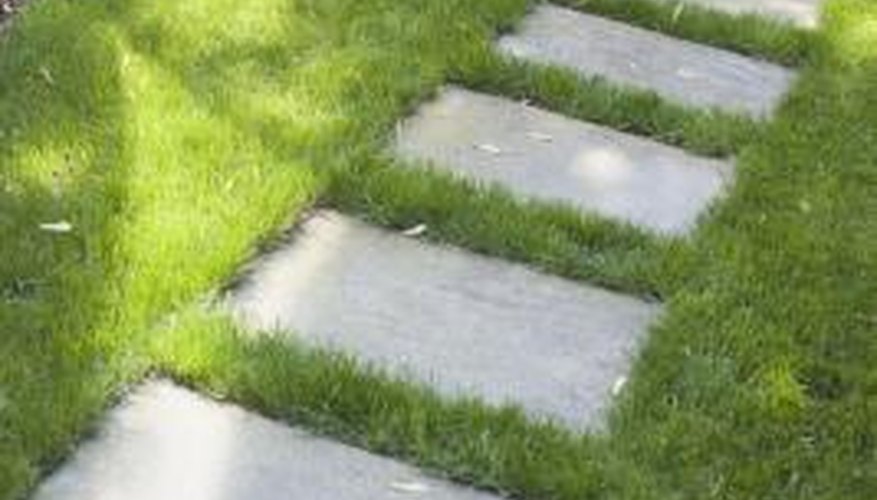Flagstone is a term for any large flat stone, either cut from a quarry or found naturally. Flagstones may be a variety of rock including sandstone, limestone, quartz and granite and come in many colours. Natural stones, created by the fracturing of rock layers, are irregular in size and shape and usually have irregular surfaces. Quarried stones are cut from thick layers of rock and are more uniform in size and shape. Either style can be used for patios, walkways or other paved surfaces around a house. Flagstones can be set in mortar or concrete or laid on sand.
Choose the area for flagstone installation. The ground does not have to be level, although patios and similar surfaces need to be smooth. Decide whether to lay flagstones as a solid surface or as individual stones, with varying gaps between them. Base this decision on the type of stone; natural stones are irregular and lend themselves to individual installation. Use either style for walkways or patios and sitting areas; quarried stones are easier to fit into formal spaces like squares and rectangles.
- Flagstone is a term for any large flat stone, either cut from a quarry or found naturally.
- Base this decision on the type of stone; natural stones are irregular and lend themselves to individual installation.
Lay flagstones on individual beds in uneven ground by placing the stone and tracing its outline in the ground with a trowel or shovel. Dig out that area to twice the depth of the stone, fill it with sand, compact the sand with a tamper and set the stone in place. Adjust the sand base to accommodate the stone until it is solid and does not rock or tilt under pressure. Fill around the set stone with dirt to make it even with the ground. Place stones uniformly or randomly, depending on the type of stone, the ground and personal preference.
- Lay flagstones on individual beds in uneven ground by placing the stone and tracing its outline in the ground with a trowel or shovel.
Make a solid stone walkway on uneven ground using stair steps. Outline the area with a garden hose or stakes and builder's twine, trace that pattern in the ground with a shovel and excavate it to twice the depth of the stones. Set 2-by-4-inch boards on edge across the pathway at step intervals, fill the area with sand, smooth it with a board. compact it and place the stones up to the 2-by-4 marker. Once one area is filled, remove the board and set the next level of stones, abutting the previous level to hold it in place. Work in increments, each sloping slightly toward the next. Vary this technique to build multi-level patios on uneven or sloping ground.
Use sod or existing grass to cover the spaces between individual flagstones. Regular quarried stones look best with uniform spacing at about stepping length and with grass intervals. Fill spaces between solidly laid stones with fine sand swept into the joints. As an alternative, build a bed of concrete and set stones in that, then fill the gaps with cement. Use a concrete bed where drainage is a major issue and water might wash into the flagstones.
TIP
Big flagstones can be heavy; get help lifting and setting.
